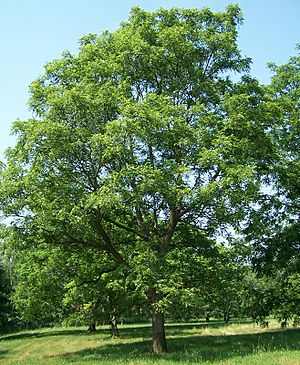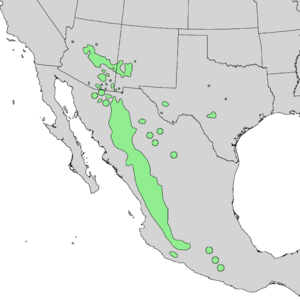Arizona black walnut facts for kids
Quick facts for kids Arizona black walnut |
|
|---|---|
 |
|
| Juglans major Morton Arboretum |
|
| Scientific classification | |
| Genus: |
Juglans
|
| Species: |
major
|
 |
|
| Natural range of Juglans major | |
| Synonyms | |
|
|
The Juglans major, also known as the Arizona walnut, is a type of walnut tree. It gets its name "major" because it means "larger" in Latin. This tree can grow up to 50 feet (15 meters) tall. Its trunk can become as wide as 2 feet (0.6 meters) across.
You can find the Arizona walnut growing in places like Texas, Oklahoma, New Mexico, Arizona, and Utah. It grows in areas that are 1,000 to 7,000 feet (300 to 2,100 meters) above sea level. It also grows in Mexico, reaching as far south as Guerrero. People sometimes call it the Arizona black walnut because it belongs to the group of "black walnuts." In Spanish, it is called nogal cimarrón, which means "cimarron walnut."
About the Arizona Walnut Tree
The Arizona walnut tree looks different depending on where it grows. In places with more moisture, it usually has one strong, thick trunk. But in drier areas, it often has several thinner trunks instead.
Leaves and Nuts
The leaves of the Arizona walnut are quite long, about 8 to 14 inches (20 to 36 cm). Each leaf is made up of 9 to 15 smaller leaflets. These leaflets are shaped like a spear, about 0.75 to 1.25 inches (1.9 to 3.2 cm) wide and 2 to 4 inches (5.1 to 10.2 cm) long.
The tree produces small nuts. These nuts have a very thick shell with deep grooves on the outside. Inside the shell, there is an oily, edible seed.
Where Different Walnuts Meet
Sometimes, the area where the Arizona walnut (J. major) grows overlaps with another type of walnut called J. microcarpa. When this happens, the two different walnut trees can breed together. This creates many trees that are a mix of both types.

